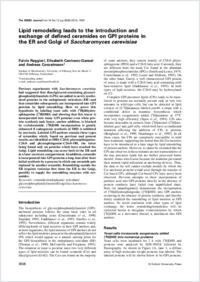Lipid remodeling leads to the introduction and exchange of defined ceramides on GPI proteins in the ER and Golgi of Saccharomyces cerevisiae.
- Reggiori F Institute of Biochemistry, University of Fribourg, Switzerland.
- Canivenc-Gansel E
- Conzelmann A
- 1997-06-01
Published in:
- The EMBO journal. - 1997
Ceramides
Cycloheximide
Endoplasmic Reticulum
Glycosylphosphatidylinositols
Golgi Apparatus
Lipid Metabolism
Protein Synthesis Inhibitors
Saccharomyces cerevisiae
Sphingolipids
Sphingosine
Tritium
English
Previous experiments with Saccharomyces cerevisiae had suggested that diacylglycerol-containing glycosylphosphatidylinositols (GPIs) are added to newly synthesized proteins in the endoplasmic reticulum (ER) and that ceramides subsequently are incorporated into GPI proteins by lipid remodeling. Here we prove this hypothesis by labeling yeast cells with [3H]dihydrosphingosine ([3H]DHS) and showing that this tracer is incorporated into many GPI proteins even when protein synthesis and, hence, anchor addition, is blocked by cycloheximide. [3H]DHS incorporation is greatly enhanced if endogenous synthesis of DHS is inhibited by myriocin. Labeled GPI anchors contain three types of ceramides which, based on previous and present results, are identified as DHS-C26:0, phytosphingosine-C26:0 and phytosphingosine-C26:0-OH, the latter being found only on proteins which have reached the Golgi. Lipid remodeling can occur both in the ER and in a later secretory compartment. In addition, ceramide is incorporated into GPI proteins a long time after their initial synthesis by a process in which one ceramide gets replaced by another ceramide. Remodeling outside the ER requires vesicular flow from the ER to the Golgi, possibly to supply the remodeling enzymes with ceramides.
- Language
-
- English
- Open access status
- green
- Identifiers
-
- DOI 10.1093/emboj/16.12.3506
- PMID 9218793
- Persistent URL
- https://sonar.ch/global/documents/189369
Statistics
Document views: 8
File downloads:
- fulltext.pdf: 0
